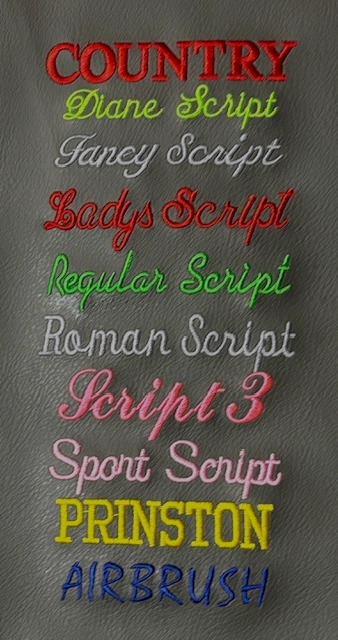The Art of Custom-made Needlework: Opening the Keys to Creating One-of-a-kind and Unforgettable Layouts
Needlework, a craft soaked in practice and creativity, holds within its intricate stitches the power to transform fabric into a canvas of distinct expression. The tricks to creating custom-made needlework styles that mesmerize the eye and leave an enduring impression depend on a fragile equilibrium of method, imagination, and focus to detail. As we explore the globe of personalized needlework, we uncover the nuanced interplay in between string choice, stitch complexity, and design personalization that boosts a plain garment to a job of art. Join us on a journey via the art of custom-made needlework as we decipher the secrets behind crafting really remarkable and distinct developments.
Choosing the Right Needlework Threads
When choosing embroidery threads, what key elements should you think about to make sure the best outcomes for your custom-made layouts? The selection of needlework string is vital in identifying the final outcome of your embroidered design.
Moreover, the weight or density of the string plays a substantial duty in the appearance of the needlework. Thicker threads can add dimension and texture to your design, while finer threads are perfect for detailed details and little text. In addition, considering the shade fastness and washability of the string is essential to guarantee that your custom styles preserve their quality and vibrancy gradually. By carefully evaluating these factors and choosing high-grade strings that fulfill your details requirements, you can enhance the aesthetic charm and durability of your stitched developments.
Exploring Different Stitch Methods
To look into the world of 'Discovering Various Stitch Techniques', one have to realize the details and nuances that each sewing technique gives the art of embroidery. Various stitch strategies not only include visual rate of interest however likewise add to the overall structure and measurement of the style. One prominent stitch strategy is the satin stitch, which involves very closely packed parallel stitches to create a smooth and shiny surface area, perfect for completing forms and creating vibrant details.
On the other hand, the backstitch is a flexible method often made use of for detailing and including great details. It involves stitching backward to create a solid line of embroidery. Furthermore, the French knot stitch adds a responsive component to styles, perfect for producing textured accents like flower facilities or attractive touches.
Exploring different stitch techniques enables embroiderers to play with light, shadow, and depth within their styles, elevating the aesthetic charm and creative high quality of their needlework jobs. By grasping numerous stitching techniques, one can unlock limitless opportunities for creating special and memorable custom-made needlework pieces.
Incorporating Personalized Design Aspects
Having actually checked out the details of different stitch strategies such as the satin stitch, backstitch, and French knot, the focus currently moves towards incorporating tailored style elements in personalized embroidery projects. Customized style aspects play an essential duty in making embroidery tasks genuinely special and remarkable.
Another means to incorporate tailored style components is by including signs or concepts that hold special definition to the recipient or reflect their passions and personality. Integrating a favorite flower, pet, or hobby-related symbol can make the needlework layout much more significant and personalized. Furthermore, picking colors that reverberate with the recipient or straighten with the intended style can further improve the customization of the embroidery task.
Grasping the Art of Shade Coordination

One key element of color control is comprehending shade theory. This includes recognizing exactly how different shades communicate with each various other, the emotions they share, and exactly how they can be combined to develop visually attractive designs. why not try this out By using color theory concepts, embroiderers can develop harmonious color schemes that boost the total look of the style.
Furthermore, taking notice of comparison is essential in color control. Making use of contrasting colors can aid particular components check out this site of the layout pop, boost legibility, and create a visually dynamic embroidery item. By understanding the art of color sychronisation, embroiderers can raise their styles and develop remarkable pieces that resonate with clients and audiences alike.
Enhancing Structure With Advanced Needlework Stitches
French knots, for instance, are best for including tiny, elevated dots to your design, imitating the look of beads or creating a distinctive surface area. Bullion knots, on the various other hand, can be made use of to develop twisted, ropelike elements that include a glamorous feeling to the needlework. Seed stitching includes small, scattered stitches that can fill out areas with a speckled texture, while turkey work creates fluffy, dimensional accents reminiscent of pet fur or vegetation. Try out these sophisticated embroidery stitches enables you to push the boundaries of conventional needlework and develop genuinely special and aesthetically attractive textures in your styles.
Conclusion
To conclude, the art of custom embroidery entails a mix of choosing the appropriate strings, exploring various stitch techniques, including tailored style elements, understanding shade coordination, and boosting texture with innovative stitches. By comprehending and implementing these vital elements, embroiderers can create one-of-a-kind and unforgettable layouts that showcase their creative thinking and ability. Embroidery enthusiasts can open the secrets to producing gorgeous and custom pieces that attract attention and leave a long lasting impact.